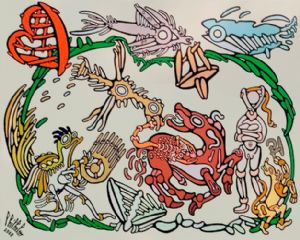| |

|

|
M90 - HORSE MINOAN STUNG - 2008
Painting Acrylic
Size: 95 x 120 cm.- 37,4 x 47,2 inches
7260 USD
Description:
MINOAN / (Text translated by Google) / This table is filled with symbols from Minoan seals without power for much, they decide to sacred connotations of personal seals to identify the owner of a mark on a door or a good seal. The scorpion, as already mentioned in a previous picture was likely to frighten those who would break the seal. The horse remaining on the island of Crete at this early period, not surprising, since the oldest known image of the world comes a rider on horseback Site Cretan Prinia, it dates from the second millennium BC In addition The myth of horses from the Mediterranean sea is ... Poseidon and the horses of Ishmael, Abraham's son reminds us. The horse in our table has 3400 years, it has been discovered on a sardonyx lento´de 15 mm in diameter at Knossos. The skinned bird and two fishes (the middle one Marine could be an insect?) Are quite distinctive style oversimplified Minoan sculptors. Remember, these fees are sometimes measured in millimeters or rarely less than two centimeters in the rare-ring seals of royal gold? At the extreme top left representation of a leaf after a plant of the island? On the same side below, a lyrebird very reworked by the artist, lower middle: two possible interpretations: the top of a cactus or a lion's head without eyes?
A Minoan assists idly on the scene, why the arms folded? Because many statues of the Cyclades Aegean show women naked, standing, arms crossed! Finally, the dog takes the Minoan monogram Philhelm in his left leg.
Lento´de: lens-shaped, the Egyptians adopt much later form called "scarab" approximately around 2000 BC
Sard: brown variety, sometimes a red chalcedony: that is to say, a translucent crystalline silica is widely used in jewelry in ancient times for jewelry and stamps. If it is an orange-red carnelian. Brown, a sardonyx. Green, a chrysoprase, onyx black =.
Cyclades in the southern Aegean Sea, about 2,200 islands, islets and islets, rocks, so called because they form a circle. The Cycladic civilization, famous for its marble idols, is even older than the Minoan civilization of Crete.
|
|

|
|